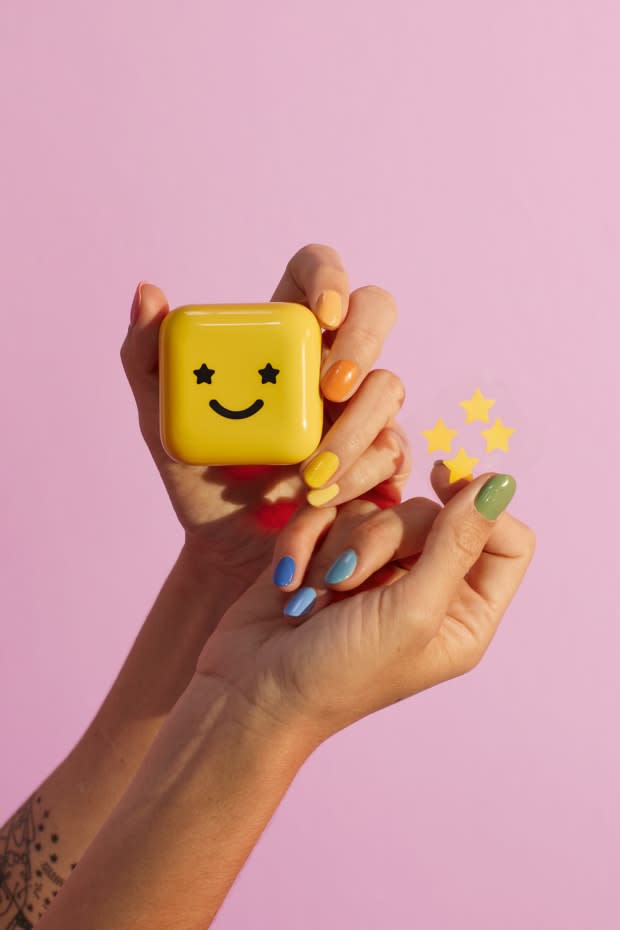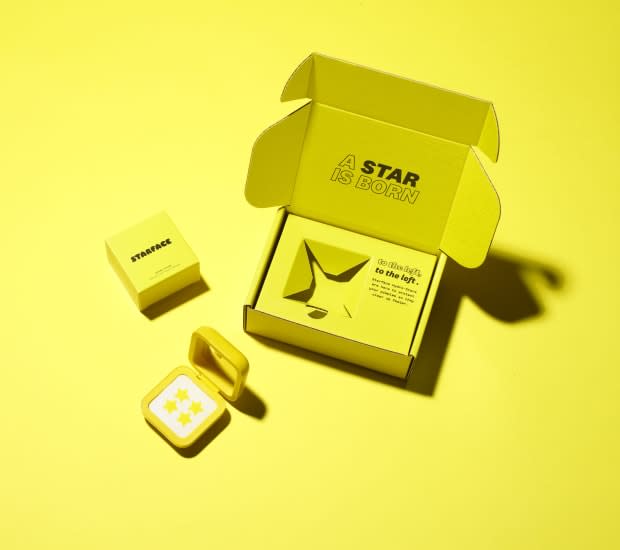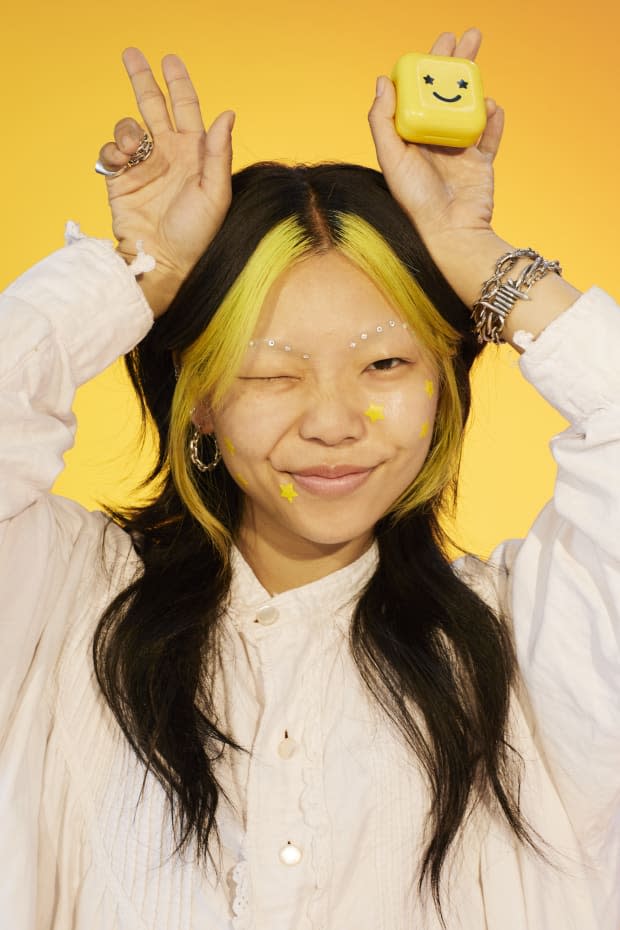New Skin-Care Brand Starface Is on a Mission to Make Acne Instagrammable
Founded by a former beauty editor, the single-SKU line wants to make people rethink existing stigmas around breakouts.

Acne affects up to 50 million Americans every year, making it the most common skin condition in the United States today. And while it may be routinely, and naively, associated with high school yearbook photos and peak puberty years, the rate of acne occurring in adults is increasing, according to a recent study by the American Academy of Dermatology. So why, if it's so common, is acne still so taboo?
It's a question that warrants a layered response, a mixture of misguided stigmas and half-baked understandings of hygiene and cleanliness, that ultimately hasn't made pimples feel as liberating as body hair, or stretch marks or any of the other things we were once conditioned to hate about bodies but are slowly coming to accept and even celebrate. But for Julie Schott, former beauty director of ELLE.com and 10-year veteran in the beauty publishing world, that answer wasn't good enough for her.
On Thursday, alongside co-founder Brian Bordainick, Schott introduces Starface, a new skin-care brand that wants to make the process of treating breakouts, scars and spots not only effective, but fun, too. The brand’s sole debut product, the Hydro-Star, is a star-shaped pimple patch made with hydrocolloid, a substance commonly used in surgical dressings that’s been proven to accelerate breakout healing. And while the brand was founded for a number of reasons, Schott had grown particularly tired of seeing the negative language used to describe acne by not only her peers, but by the products and professionals that people often turn to for help with the very issue.
"You get a lot of unsolicited advice, and it feels like kind of hurtful, you know?" Schott shared over the phone. "When you go for a facial and facialist is like, 'Aww, what is that? What is that break out? Could you try this, this and this?' And you think to yourself like, yeah man, I have done all the research, I have tried those things. They don't happen to work for me, they were actually making it worse. So it was one of those problems that can really compound itself."
Related Articles
Back to Basics: How to Cure Adult Acne
Hey, Quick Question: Why Do I Keep Breaking Out in the Same Spot?
13 Skin-Care Products to Help (Finally) Fade Your Acne Scars
Starface's single SKU at launch is a pack of teeny, jelly-looking patches (in the shape of little yellow stars) that work to draw out pimple pus, block outside bacteria from the blemish and prevent poking and picking, which is notorious for causing scarring or other irritation. There are 32 stickers — all vegan and Leaping Bunny certified — packaged in each of the bright yellow, cartoonish pods, which will retail for $22. They also happen to look like those adhesive stickers people put on their faces ahead of Coachella for a look, which along with the Gen-Z, internet aesthetic of the brand's overall identity, was a measured decision in an effort to make, as Schott says, dealing with acne fun.

"There has been a ton of innovation since I started in the beauty industry," says Schott. "It is more inclusive in the sense of who products are marketed to and the barrier to entry, and that so many people are now creators and solving some problems that have touched them. That is kind of what made this possible. To take all of the learning that I had, a combination of being a beauty editor and just as a person who has done the research and that has dealt with acne. I funneled it into something that I saw was missing."
Ahead of the brand's launch, I spoke with Schott over the phone about her transition from beauty editor to beauty brand, her own experiences with acne and her mission of making information — and science — accessible. Read on for highlights of our conversation below.
What led you to consider making your own product, in the acne space specifically?
On my first day of work [at XoJane] I wore a baseball cap. I had terrible acne, and I remember being so upset about it. Being a beauty editor, I felt like it took away from my credibility that I had not figured out how to sort out my skin. But the reason is because 95% of people have acne and that's just the way it goes.
I remember distinctly having this thought in 2015: I was like, I wish that I could put decorative medicated stickers all over this. I must have at that point seen the kind of entry-level circular hydrocolloid patches somewhere. I don't think they were as available in the U.S. back then. I just remember thinking, duh, let's make these things decorative.
Fast-forward to 2017, I knew that I wanted to make something for people who were dealing with acne or pimples or breakouts that combined education with safe, effective ingredients. But I wanted to make that appealing; I love the clinical stuff, but for some people the price point isn't inclusive, or it's just not available for everyone. It's the same with seeing a dermatologist. A lot of people get their skin-care information from sites like Fashionista, or Reddit threads or Instagram. So just being as available and accessible as possible is really important to me.

What did you think Starface was going to bring into the acne space that wasn't already being done?
Just how it makes you feel. We've been posting since probably around December on Starface's Instagram, and I had no idea that it would resonate with people and it really has. Seeing people post their pimples and decorate them and be silly and weird — there are no sad faces, there's no sad language. Of course you're entitled to feel exactly how you feel, everyone is human and moods fluctuate and feelings toward yourself fluctuate. But the whole idea was to normalize and de-stigmatize this thing that's so common, and should absolutely not be seen as disgusting or like you don't know how to take care of yourself.
It's the most normal thing in the world. [Starface] is supposed to be fun, down to the packaging. I like looking at it. I wanted it to make the user feel good when they're looking at it.
How did you go about formulation and production once you knew what you wanted the brand to be and offer?
Since we're one SKU, it was really important to choose a treatment that was as safe and as proven as possible, and so hydrocolloid was a really natural fit for that. Hydrocolloid has been used on wounds as far back as WWI — it's proven to draw out infection and protect from bacteria from getting in. In pimples, it draws out fluid, it keeps your from picking. I'm the biggest skin picker in the world; if you're doing that, you're facing at least a month or so in recovery.
I thought that finding hydrocolloid and custom tooling it would be fairly easy — it wasn't. We knocked on countless doors of people who were like, 'We love it, but we don't do that,' or people like, 'We don't really get it, and we also don't do that.' Over and over and over. Finally, we found a medical manufacturer who makes bandaids and medical supplies, and they shockingly did get it, and executed to perfection. Before that, we'd made 10 iterations of the product. They either looked too art supply or weren't securing to the face.
Were there any ingredients you were purposefully staying away from, that you knew you didn't want included in the product from your own research?
Some of the worst acne, the most surprising acne, can happen when you're pregnant. That's also when suddenly your entire skin-care regimen is potentially harmful. Maybe you can't use all of your retinols, or your glycolic or salicylic acid or benzoyl peroxide. Having a breakout when you're pregnant can be really upsetting on top of everything else you're going through. We were excited that Starface is certified safe to use when you are pregnant.
Some of the ingredients which are fantastic and proven can be irritating to anyone, not just pregnant people. Everyone's skin is different. What works for one person may not work for another person, but I can confidently say that this is safe and gentle and effective. If we can say that, then we did our job.
After a decade of testing and reviewing and learning about new products and brands, how does it feel to put your own thing out in the world? Are you scared about reactions and feedback?
I'm super excited. I'm proud of it. I love it. Whenever I get emails or DMs from people who tell me that it has already made them feel better about their skin, I am like cool, this is exactly what the goal is. Historically, a lot of the beauty industry has relied on the feelings of inadequacy or an insecurity to sell you a product. That is absolutely not what this is about. When we shot the campaign, nobody wore makeup; it was the first time I've been on set where people weren't even asking for it. There's something really safe and inviting about this.
This interview has been edited for clarity.
